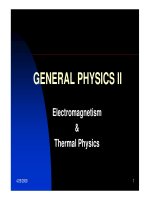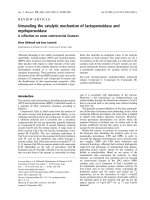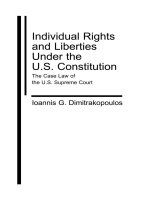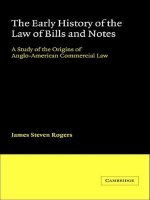The First Law of Thermodynamics and Some Simple Processes
Bạn đang xem bản rút gọn của tài liệu. Xem và tải ngay bản đầy đủ của tài liệu tại đây (2.09 MB, 15 trang )
The First Law of Thermodynamics and Some Simple Processes
The First Law of
Thermodynamics and Some
Simple Processes
Bởi:
OpenStaxCollege
Beginning with the Industrial Revolution, humans have harnessed power through the use of the
first law of thermodynamics, before we even understood it completely. This photo, of a steam
engine at the Turbinia Works, dates from 1911, a mere 61 years after the first explicit statement
of the first law of thermodynamics by Rudolph Clausius. (credit: public domain; author
unknown)
One of the most important things we can do with heat transfer is to use it to do work for
us. Such a device is called a heat engine. Car engines and steam turbines that generate
electricity are examples of heat engines. [link] shows schematically how the first law of
thermodynamics applies to the typical heat engine.
1/15
The First Law of Thermodynamics and Some Simple Processes
Schematic representation of a heat engine, governed, of course, by the first law of
thermodynamics. It is impossible to devise a system where Qout = 0, that is, in which no heat
transfer occurs to the environment.
(a) Heat transfer to the gas in a cylinder increases the internal energy of the gas, creating higher
pressure and temperature. (b) The force exerted on the movable cylinder does work as the gas
expands. Gas pressure and temperature decrease when it expands, indicating that the gas’s
2/15
The First Law of Thermodynamics and Some Simple Processes
internal energy has been decreased by doing work. (c) Heat transfer to the environment further
reduces pressure in the gas so that the piston can be more easily returned to its starting position.
The illustrations above show one of the ways in which heat transfer does work. Fuel
combustion produces heat transfer to a gas in a cylinder, increasing the pressure of the
gas and thereby the force it exerts on a movable piston. The gas does work on the
outside world, as this force moves the piston through some distance. Heat transfer to the
gas cylinder results in work being done. To repeat this process, the piston needs to be
returned to its starting point. Heat transfer now occurs from the gas to the surroundings
so that its pressure decreases, and a force is exerted by the surroundings to push the
piston back through some distance. Variations of this process are employed daily in
hundreds of millions of heat engines. We will examine heat engines in detail in the next
section. In this section, we consider some of the simpler underlying processes on which
heat engines are based.
PV Diagrams and their Relationship to Work Done on or by a Gas
A process by which a gas does work on a piston at constant pressure is called an isobaric
process. Since the pressure is constant, the force exerted is constant and the work done
is given as
PΔV.
An isobaric expansion of a gas requires heat transfer to keep the pressure constant. Since
pressure is constant, the work done is PΔV.
W = Fd
See the symbols as shown in [link]. Now F = PA, and so
W = PAd.
3/15
The First Law of Thermodynamics and Some Simple Processes
Because the volume of a cylinder is its cross-sectional area A times its length d, we see
that Ad = ΔV, the change in volume; thus,
W = PΔV (isobaric process).
Note that if ΔV is positive, then W is positive, meaning that work is done by the gas on
the outside world.
(Note that the pressure involved in this work that we’ve called P is the pressure of
the gas inside the tank. If we call the pressure outside the tank Pext, an expanding gas
would be working against the external pressure; the work done would therefore be
W = − PextΔV (isobaric process). Many texts use this definition of work, and not the
definition based on internal pressure, as the basis of the First Law of Thermodynamics.
This definition reverses the sign conventions for work, and results in a statement of the
first law that becomes ΔU = Q + W.)
It is not surprising that W = PΔV, since we have already noted in our treatment of fluids
that pressure is a type of potential energy per unit volume and that pressure in fact has
units of energy divided by volume. We also noted in our discussion of the ideal gas law
that PV has units of energy. In this case, some of the energy associated with pressure
becomes work.
[link] shows a graph of pressure versus volume (that is, a PV diagram for an isobaric
process. You can see in the figure that the work done is the area under the graph. This
property of PV diagrams is very useful and broadly applicable: the work done on or by
a system in going from one state to another equals the area under the curve on a PV
diagram.
A graph of pressure versus volume for a constant-pressure, or isobaric, process, such as the one
shown in [link]. The area under the curve equals the work done by the gas, since W = PΔV.
4/15
The First Law of Thermodynamics and Some Simple Processes
(a) A PV diagram in which pressure varies as well as volume. The work done for each interval is
its average pressure times the change in volume, or the area under the curve over that interval.
Thus the total area under the curve equals the total work done. (b) Work must be done on the
system to follow the reverse path. This is interpreted as a negative area under the curve.
We can see where this leads by considering [link](a), which shows a more general
process in which both pressure and volume change. The area under the curve is closely
approximated by dividing it into strips, each having an average constant pressure Pi(ave)
. The work done is Wi = Pi(ave)ΔVi for each strip, and the total work done is the sum of
the Wi. Thus the total work done is the total area under the curve. If the path is reversed,
as in [link](b), then work is done on the system. The area under the curve in that case is
negative, because ΔV is negative.
PV diagrams clearly illustrate that the work done depends on the path taken and not
just the endpoints. This path dependence is seen in [link](a), where more work is done
in going from A to C by the path via point B than by the path via point D. The
vertical paths, where volume is constant, are called isochoric processes. Since volume
is constant, ΔV = 0, and no work is done in an isochoric process. Now, if the system
follows the cyclical path ABCDA, as in [link](b), then the total work done is the area
inside the loop. The negative area below path CD subtracts, leaving only the area inside
the rectangle. In fact, the work done in any cyclical process (one that returns to its
starting point) is the area inside the loop it forms on a PV diagram, as [link](c) illustrates
for a general cyclical process. Note that the loop must be traversed in the clockwise
direction for work to be positive—that is, for there to be a net work output.
5/15
The First Law of Thermodynamics and Some Simple Processes
(a) The work done in going from A to C depends on path. The work is greater for the path ABC
than for the path ADC, because the former is at higher pressure. In both cases, the work done is
the area under the path. This area is greater for path ABC. (b) The total work done in the
cyclical process ABCDA is the area inside the loop, since the negative area below CD subtracts
out, leaving just the area inside the rectangle. (The values given for the pressures and the
change in volume are intended for use in the example below.) (c) The area inside any closed
loop is the work done in the cyclical process. If the loop is traversed in a clockwise direction, W
is positive—it is work done on the outside environment. If the loop is traveled in a counterclockwise direction, W is negative—it is work that is done to the system.
Total Work Done in a Cyclical Process Equals the Area Inside the Closed Loop on a
PV Diagram
Calculate the total work done in the cyclical process ABCDA shown in [link](b) by the
following two methods to verify that work equals the area inside the closed loop on the
PV diagram. (Take the data in the figure to be precise to three significant figures.) (a)
6/15
The First Law of Thermodynamics and Some Simple Processes
Calculate the work done along each segment of the path and add these values to get the
total work. (b) Calculate the area inside the rectangle ABCDA.
Strategy
To find the work along any path on a PV diagram, you use the fact that work is pressure
times change in volume, or W = PΔV. So in part (a), this value is calculated for each leg
of the path around the closed loop.
Solution for (a)
The work along path AB is
WAB
=
PABΔVAB
=
(1.50×106 N/m2)(5.00×10–4 m3) = 750 J.
Since the path BC is isochoric, ΔVBC = 0, and so WBC = 0. The work along path CD is
negative, since ΔVCD is negative (the volume decreases). The work is
WCD
=
PCDΔVCD
=
(2.00×105 N/m2)(–5.00×10–4 m3) = –100 J.
Again, since the path DA is isochoric, ΔVDA = 0, and so WDA = 0. Now the total work is
W
=
WAB + WBC + WCD + WDA
=
750 J+0 + ( − 100J) + 0 = 650 J.
Solution for (b)
The area inside the rectangle is its height times its width, or
area
=
(PAB − PCD)ΔV
=
[(1.50×106 N/m2) − (2.00×105 N/m2)](5.00×10 − 4 m3)
=
650 J.
Thus,
area=650 J = W.
Discussion
7/15
The First Law of Thermodynamics and Some Simple Processes
The result, as anticipated, is that the area inside the closed loop equals the work done.
The area is often easier to calculate than is the work done along each path. It is also
convenient to visualize the area inside different curves on PV diagrams in order to see
which processes might produce the most work. Recall that work can be done to the
system, or by the system, depending on the sign of W. A positive W is work that is done
by the system on the outside environment; a negative W represents work done by the
environment on the system.
[link](a) shows two other important processes on a PV diagram. For comparison, both
are shown starting from the same point A. The upper curve ending at point B is
an isothermal process—that is, one in which temperature is kept constant. If the gas
behaves like an ideal gas, as is often the case, and if no phase change occurs, then
PV=nRT . Since T is constant, PV is a constant for an isothermal process. We ordinarily
expect the temperature of a gas to decrease as it expands, and so we correctly suspect
that heat transfer must occur from the surroundings to the gas to keep the temperature
constant during an isothermal expansion. To show this more rigorously for the special
case of a monatomic ideal gas, we note that the average kinetic energy of an atom in
such a gas is given by
1 ¯2
2 mv
3
= 2 kT.
The kinetic energy of the atoms in a monatomic ideal gas is its only form of internal
energy, and so its total internal energy U is
1 ¯2
3
U = N 2 mv = 2 NkT, (monatomic ideal gas),
where N is the number of atoms in the gas. This relationship means that the internal
energy of an ideal monatomic gas is constant during an isothermal process—that is,
ΔU = 0. If the internal energy does not change, then the net heat transfer into the gas
must equal the net work done by the gas. That is, because ΔU = Q − W = 0 here, Q = W.
We must have just enough heat transfer to replace the work done. An isothermal process
is inherently slow, because heat transfer occurs continuously to keep the gas temperature
constant at all times and must be allowed to spread through the gas so that there are no
hot or cold regions.
Also shown in [link](a) is a curve AC for an adiabatic process, defined to be one in
which there is no heat transfer—that is, Q = 0. Processes that are nearly adiabatic can be
achieved either by using very effective insulation or by performing the process so fast
that there is little time for heat transfer. Temperature must decrease during an adiabatic
process, since work is done at the expense of internal energy:
3
U = 2 NkT.
8/15
The First Law of Thermodynamics and Some Simple Processes
(You might have noted that a gas released into atmospheric pressure from a pressurized
cylinder is substantially colder than the gas in the cylinder.) In fact, because
Q = 0, ΔU = – W for an adiabatic process. Lower temperature results in lower pressure
along the way, so that curve AC is lower than curve AB, and less work is done. If
the path ABCA could be followed by cooling the gas from B to C at constant volume
(isochorically), [link](b), there would be a net work output.
(a) The upper curve is an isothermal process (ΔT = 0), whereas the lower curve is an adiabatic
process (Q = 0). Both start from the same point A, but the isothermal process does more work
than the adiabatic because heat transfer into the gas takes place to keep its temperature
constant. This keeps the pressure higher all along the isothermal path than along the adiabatic
path, producing more work. The adiabatic path thus ends up with a lower pressure and
temperature at point C, even though the final volume is the same as for the isothermal process.
(b) The cycle ABCA produces a net work output.
Reversible Processes
Both isothermal and adiabatic processes such as shown in [link] are reversible in
principle. A reversible process is one in which both the system and its environment
can return to exactly the states they were in by following the reverse path. The reverse
isothermal and adiabatic paths are BA and CA, respectively. Real macroscopic
processes are never exactly reversible. In the previous examples, our system is a gas
(like that in [link]), and its environment is the piston, cylinder, and the rest of the
universe. If there are any energy-dissipating mechanisms, such as friction or turbulence,
then heat transfer to the environment occurs for either direction of the piston. So, for
example, if the path BA is followed and there is friction, then the gas will be returned
9/15
The First Law of Thermodynamics and Some Simple Processes
to its original state but the environment will not—it will have been heated in both
directions. Reversibility requires the direction of heat transfer to reverse for the reverse
path. Since dissipative mechanisms cannot be completely eliminated, real processes
cannot be reversible.
There must be reasons that real macroscopic processes cannot be reversible. We can
imagine them going in reverse. For example, heat transfer occurs spontaneously from
hot to cold and never spontaneously the reverse. Yet it would not violate the first
law of thermodynamics for this to happen. In fact, all spontaneous processes, such as
bubbles bursting, never go in reverse. There is a second thermodynamic law that forbids
them from going in reverse. When we study this law, we will learn something about
nature and also find that such a law limits the efficiency of heat engines. We will find
that heat engines with the greatest possible theoretical efficiency would have to use
reversible processes, and even they cannot convert all heat transfer into doing work.
[link] summarizes the simpler thermodynamic processes and their definitions.
Summary of Simple
Thermodynamic Processes
Isobaric
Constant pressure
W = PΔV
Isochoric
Constant volume
W=0
Isothermal
Constant temperature
Q=W
Adiabatic
No heat transfer
Q=0
PhET Explorations: States of Matter
Watch different types of molecules form a solid, liquid, or gas. Add or remove heat
and watch the phase change. Change the temperature or volume of a container and see
a pressure-temperature diagram respond in real time. Relate the interaction potential to
the forces between molecules.
States of Matter
10/15
The First Law of Thermodynamics and Some Simple Processes
Section Summary
• One of the important implications of the first law of thermodynamics is that
machines can be harnessed to do work that humans previously did by hand or
by external energy supplies such as running water or the heat of the Sun. A
machine that uses heat transfer to do work is known as a heat engine.
• There are several simple processes, used by heat engines, that flow from the
first law of thermodynamics. Among them are the isobaric, isochoric,
isothermal and adiabatic processes.
• These processes differ from one another based on how they affect pressure,
volume, temperature, and heat transfer.
• If the work done is performed on the outside environment, work (W) will be a
positive value. If the work done is done to the heat engine system, work (W)
will be a negative value.
• Some thermodynamic processes, including isothermal and adiabatic processes,
are reversible in theory; that is, both the thermodynamic system and the
environment can be returned to their initial states. However, because of loss of
energy owing to the second law of thermodynamics, complete reversibility
does not work in practice.
Conceptual Questions
A great deal of effort, time, and money has been spent in the quest for the so-called
perpetual-motion machine, which is defined as a hypothetical machine that operates or
produces useful work indefinitely and/or a hypothetical machine that produces more
work or energy than it consumes. Explain, in terms of heat engines and the first law of
thermodynamics, why or why not such a machine is likely to be constructed.
One method of converting heat transfer into doing work is for heat transfer into a gas to
take place, which expands, doing work on a piston, as shown in the figure below. (a) Is
the heat transfer converted directly to work in an isobaric process, or does it go through
another form first? Explain your answer. (b) What about in an isothermal process? (c)
What about in an adiabatic process (where heat transfer occurred prior to the adiabatic
process)?
11/15
The First Law of Thermodynamics and Some Simple Processes
Would the previous question make any sense for an isochoric process? Explain your
answer.
We ordinarily say that ΔU = 0 for an isothermal process. Does this assume no phase
change takes place? Explain your answer.
The temperature of a rapidly expanding gas decreases. Explain why in terms of the first
law of thermodynamics. (Hint: Consider whether the gas does work and whether heat
transfer occurs rapidly into the gas through conduction.)
Which cyclical process represented by the two closed loops, ABCFA and ABDEA, on
the PV diagram in the figure below produces the greatest net work? Is that process also
the one with the smallest work input required to return it to point A? Explain your
responses.
12/15
The First Law of Thermodynamics and Some Simple Processes
The two cyclical processes shown on this PV diagram start with and return the system to the
conditions at point A, but they follow different paths and produce different amounts of work.
A real process may be nearly adiabatic if it occurs over a very short time. How does the
short time span help the process to be adiabatic?
It is unlikely that a process can be isothermal unless it is a very slow process. Explain
why. Is the same true for isobaric and isochoric processes? Explain your answer.
Problem Exercises
A car tire contains 0.0380 m3 of air at a pressure of 2.20×105 N/m2 (about 32 psi). How
much more internal energy does this gas have than the same volume has at zero gauge
pressure (which is equivalent to normal atmospheric pressure)?
6.77 × 103 J
A helium-filled toy balloon has a gauge pressure of 0.200 atm and a volume of 10.0 L.
How much greater is the internal energy of the helium in the balloon than it would be at
zero gauge pressure?
Steam to drive an old-fashioned steam locomotive is supplied at a constant gauge
pressure of 1.75×106 N/m2 (about 250 psi) to a piston with a 0.200-m radius. (a) By
calculating PΔV, find the work done by the steam when the piston moves 0.800 m. Note
that this is the net work output, since gauge pressure is used. (b) Now find the amount
of work by calculating the force exerted times the distance traveled. Is the answer the
same as in part (a)?
(a) W = PΔV = 1.76 × 105 J
(b) W = Fd = 1.76 × 105 J. Yes, the answer is the same.
13/15
The First Law of Thermodynamics and Some Simple Processes
A hand-driven tire pump has a piston with a 2.50-cm diameter and a maximum stroke
of 30.0 cm. (a) How much work do you do in one stroke if the average gauge pressure
is 2.40×105 N/m2 (about 35 psi)? (b) What average force do you exert on the piston,
neglecting friction and gravitational force?
Calculate the net work output of a heat engine following path ABCDA in the figure
below.
W = 4.5 × 103 J
What is the net work output of a heat engine that follows path ABDA in the figure
above, with a straight line from B to D? Why is the work output less than for path
ABCDA? Explicitly show how you follow the steps in the Problem-Solving Strategies
for Thermodynamics.
Unreasonable Results
What is wrong with the claim that a cyclical heat engine does 4.00 kJ of work on an
input of 24.0 kJ of heat transfer while 16.0 kJ of heat transfers to the environment?
W is not equal to the difference between the heat input and the heat output.
(a) A cyclical heat engine, operating between temperatures of 450º C and 150º C
produces 4.00 MJ of work on a heat transfer of 5.00 MJ into the engine. How much
heat transfer occurs to the environment? (b) What is unreasonable about the engine? (c)
Which premise is unreasonable?
Construct Your Own Problem
14/15
The First Law of Thermodynamics and Some Simple Processes
Consider a car’s gasoline engine. Construct a problem in which you calculate the
maximum efficiency this engine can have. Among the things to consider are the
effective hot and cold reservoir temperatures. Compare your calculated efficiency with
the actual efficiency of car engines.
Construct Your Own Problem
Consider a car trip into the mountains. Construct a problem in which you calculate the
overall efficiency of the car for the trip as a ratio of kinetic and potential energy gained
to fuel consumed. Compare this efficiency to the thermodynamic efficiency quoted for
gasoline engines and discuss why the thermodynamic efficiency is so much greater.
Among the factors to be considered are the gain in altitude and speed, the mass of the
car, the distance traveled, and typical fuel economy.
15/15









